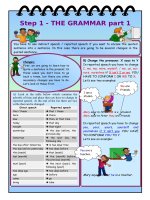5054 reported speech step by step step 1 grammar part 1
Bạn đang xem bản rút gọn của tài liệu. Xem và tải ngay bản đầy đủ của tài liệu tại đây (413.97 KB, 2 trang )
Step 1 - THE GRAMMAR part 1
You have to use indirect speech / reported speech if you want to encase the quoted
sentence into a sentence. In this case there are going to be several changes in the
quoted sentence.
Changes:
First, we are going to learn how to
quote a sentence in the present. In
these cases you don’t have to go
back a tense, but there are other
necessary changes you have to do.
Let’s look at these first.
A) Look at the table below which contains the
adverbs of time and place that you have to change
in reported speech. At the end of the list there
are two verbs that can be changed.
Direct speech
Reported speech
this / these
that / those
here
there
now
then, at that time
today
that day
tonight
that night
yesterday
the day before, the
previous day
tomorrow
the next day, the
following day
the day after tomorrow
in two days’ time
the
day
yesterday
two days before
before
this (week)
that (week)
last (month)
the (month) before,
the previous (month)
next (year)
the next (year), the
following (year)
two days ago
two days before
ago
before
come
go
bring
take
B) Change the pronouns: X says to Y
In reported speech you have to change
I, me, my, mine, myself, / we, us, our,
ours, ourselves if X isn’t I or we. YOU
HAVE TO CONFORM I OR WE TO X.
Let’s see two examples:
I am a
studen
t.
We are
friends.
Mary says to Peter she is a student.
Mary says to Peter they are friends.
In reported speech you have to change
you, your, yours, yourself and
yourselves if Y isn’t you. YOU HAVE
TO CONFORM YOU TO Y.
Let’s see an example:
You are a
teacher.
Mary says to Peter he is a teacher.
C) The order of the reported
statements.
When you encase the quoted sentence, you
have to use the following order:
D) The order of the reported
question.
Subject + Predicate (modal verb if necessary
+ verb) + Object + Adverbs (place, time …)
whether /if + Subject + Predicate (modal
verb if necessary + verb) + Object +
Adverbs (place, time)
Let’s see two examples:
• Yesterday I went to the shop.
Mary says to Peter she went to the
shop the day before.
• Now I am drawing a flower into my
notebook.
Mary says to Peter she is drawing a
flower into her notebook then.
Yes-no question:
Let’s see two examples:
• Do you like chocolate?
Mary asks Peter whether/if he likes
chocolate.
• Have you ever been to Scotland?
Mary asks Peter whether/if he has
ever been to Scotland.
Wh-question:
E)
The
order
of
the
reported
commands / suggestions / requests
You have to change the verb into
TO+INFINITIVE. If it is a negative
command you have to change it into NOT+
TO+INFINITIVE.
Let’s see two examples:
• Go to your room.
Mary tells the children to go to their
room.
• Don’t watch late night films.
Mary tells the children not to watch
late night films.
Wh-question
pronoun
+
Subject
+
Predicate (modal verb if necessary +
verb) + Object + Adverbs (place, time)
Let’s see two examples:
• Where do you usually buy food?
Mary asks Peter where he usually
buys food.
• Why have you bought this
camera?
Mary asks Peter why he has bought
that camera.
BE CAREFUL! You have to leave out
“do”, “does” and “did” if there isn’t
negation in the sentence.
The most common used verb to introduce a
reported command is ‘tell’. If there is
‘please’ in the direct command, you have
If the person is mentioned in
to use ‘ask’ and leave out ‘please.
the direct command, you have
to write it into the introduction.
e.g.: Please, don’t give up.
e.g.: Children, drink your juice.
He asks me not to give up.
Mother tells the children to drink
their juice.








